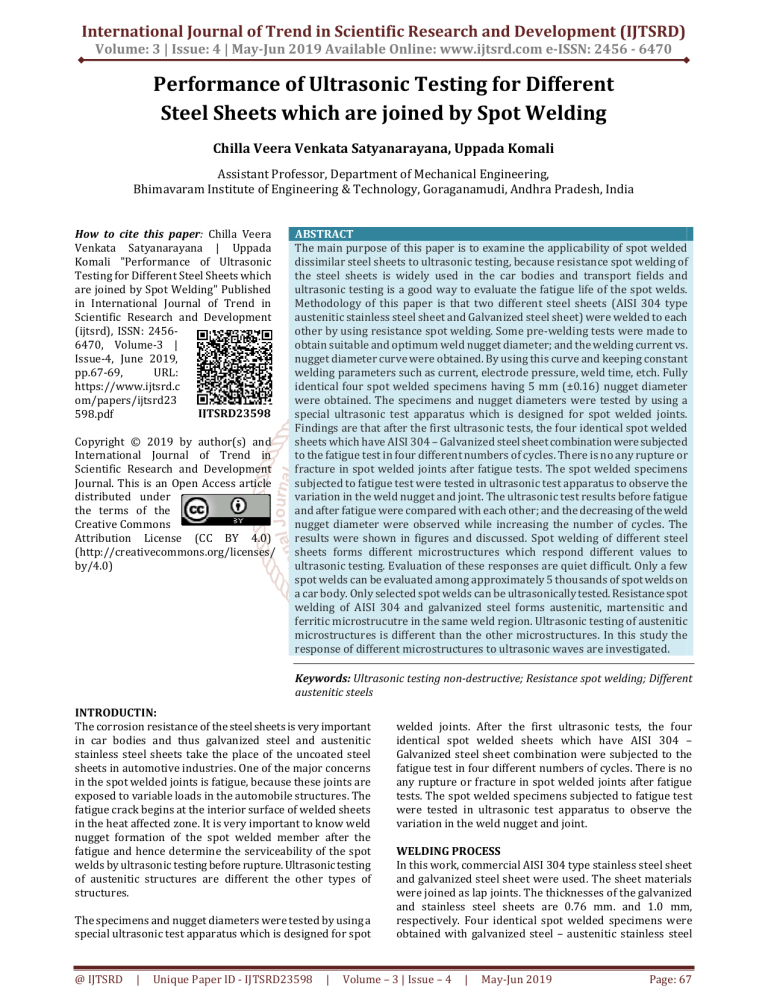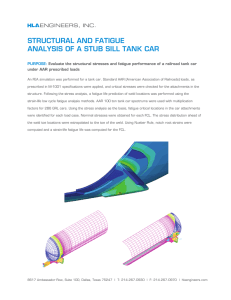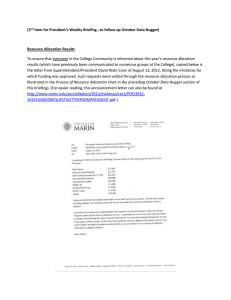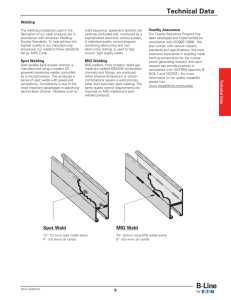
International Journal of Trend in Scientific Research and Development (IJTSRD)
Volume: 3 | Issue: 4 | May-Jun 2019 Available Online: www.ijtsrd.com e-ISSN: 2456 - 6470
Performance of Ultrasonic Testing for Different
Steel Sheets which are joined by Spot Welding
Chilla Veera Venkata Satyanarayana, Uppada Komali
Assistant Professor, Department of Mechanical Engineering,
Bhimavaram Institute of Engineering & Technology, Goraganamudi, Andhra Pradesh, India
How to cite this paper: Chilla Veera
Venkata Satyanarayana | Uppada
Komali "Performance of Ultrasonic
Testing for Different Steel Sheets which
are joined by Spot Welding" Published
in International Journal of Trend in
Scientific Research and Development
(ijtsrd), ISSN: 24566470, Volume-3 |
Issue-4, June 2019,
pp.67-69,
URL:
https://www.ijtsrd.c
om/papers/ijtsrd23
IJTSRD23598
598.pdf
Copyright © 2019 by author(s) and
International Journal of Trend in
Scientific Research and Development
Journal. This is an Open Access article
distributed under
the terms of the
Creative Commons
Attribution License (CC BY 4.0)
(http://creativecommons.org/licenses/
by/4.0)
ABSTRACT
The main purpose of this paper is to examine the applicability of spot welded
dissimilar steel sheets to ultrasonic testing, because resistance spot welding of
the steel sheets is widely used in the car bodies and transport fields and
ultrasonic testing is a good way to evaluate the fatigue life of the spot welds.
Methodology of this paper is that two different steel sheets (AISI 304 type
austenitic stainless steel sheet and Galvanized steel sheet) were welded to each
other by using resistance spot welding. Some pre-welding tests were made to
obtain suitable and optimum weld nugget diameter; and the welding current vs.
nugget diameter curve were obtained. By using this curve and keeping constant
welding parameters such as current, electrode pressure, weld time, etch. Fully
identical four spot welded specimens having 5 mm (±0.16) nugget diameter
were obtained. The specimens and nugget diameters were tested by using a
special ultrasonic test apparatus which is designed for spot welded joints.
Findings are that after the first ultrasonic tests, the four identical spot welded
sheets which have AISI 304 – Galvanized steel sheet combination were subjected
to the fatigue test in four different numbers of cycles. There is no any rupture or
fracture in spot welded joints after fatigue tests. The spot welded specimens
subjected to fatigue test were tested in ultrasonic test apparatus to observe the
variation in the weld nugget and joint. The ultrasonic test results before fatigue
and after fatigue were compared with each other; and the decreasing of the weld
nugget diameter were observed while increasing the number of cycles. The
results were shown in figures and discussed. Spot welding of different steel
sheets forms different microstructures which respond different values to
ultrasonic testing. Evaluation of these responses are quiet difficult. Only a few
spot welds can be evaluated among approximately 5 thousands of spot welds on
a car body. Only selected spot welds can be ultrasonically tested. Resistance spot
welding of AISI 304 and galvanized steel forms austenitic, martensitic and
ferritic microstrucutre in the same weld region. Ultrasonic testing of austenitic
microstructures is different than the other microstructures. In this study the
response of different microstructures to ultrasonic waves are investigated.
Keywords: Ultrasonic testing non-destructive; Resistance spot welding; Different
austenitic steels
INTRODUCTIN:
The corrosion resistance of the steel sheets is very important
in car bodies and thus galvanized steel and austenitic
stainless steel sheets take the place of the uncoated steel
sheets in automotive industries. One of the major concerns
in the spot welded joints is fatigue, because these joints are
exposed to variable loads in the automobile structures. The
fatigue crack begins at the interior surface of welded sheets
in the heat affected zone. It is very important to know weld
nugget formation of the spot welded member after the
fatigue and hence determine the serviceability of the spot
welds by ultrasonic testing before rupture. Ultrasonic testing
of austenitic structures are different the other types of
structures.
The specimens and nugget diameters were tested by using a
special ultrasonic test apparatus which is designed for spot
@ IJTSRD
|
Unique Paper ID - IJTSRD23598
|
welded joints. After the first ultrasonic tests, the four
identical spot welded sheets which have AISI 304 –
Galvanized steel sheet combination were subjected to the
fatigue test in four different numbers of cycles. There is no
any rupture or fracture in spot welded joints after fatigue
tests. The spot welded specimens subjected to fatigue test
were tested in ultrasonic test apparatus to observe the
variation in the weld nugget and joint.
WELDING PROCESS
In this work, commercial AISI 304 type stainless steel sheet
and galvanized steel sheet were used. The sheet materials
were joined as lap joints. The thicknesses of the galvanized
and stainless steel sheets are 0.76 mm. and 1.0 mm,
respectively. Four identical spot welded specimens were
obtained with galvanized steel – austenitic stainless steel
Volume – 3 | Issue – 4
|
May-Jun 2019
Page: 67
International Journal of Trend in Scientific Research and Development (IJTSRD) @ www.ijtsrd.com eISSN: 2456-6470
sheet combination and 4 mm nugget diameter. Below figure,
the photograph of the macro section of the weld nugget is
given.
The weld joint has an austenite + martensite + ferrite micro
structure. These structures have fully different properties
and grain sizes from those of base metals.
During the fatigue test, the load range and load frequency
were kept constant. The specimens exposed to the fatigue
test were investigated and it was shown that there was no
major damage and rupture on the joints between the steel
sheets. After the fatigue test, to observe the decrease of the
nugget diameter, the ultrasonic tests were repeated. The
ultrasonic test results before and after the fatigue was
monitored and compared with each other.
ULTRASONIC TEST RESULTS
In this step of the study, the results taken by ultrasonic test
apparatus were investigated and discussed. Below figure
shows the ultrasonic test results of the fatigue specimen
exposed to 25000 cycle’s fatigue. During the welding
operation a deformation is formed around the weld nugget
of 0.1 mm.
FATIGUE TESTS
The fatigue testing was performed in laboratory conditions.
All tests were performed using a sinusoidal waveform
operating at 10 Hz. During the fatigue experiments, load and
specimen displacements were recorded and monitored by
the test control system. Each four spot welded specimens
were exposed to fatigue test with 25000, 50000, 80000 and
110000 number of cycles respectively.
ULTRASONIC TESTS
Ultrasonic tests were performed before and after fatigue.
Before fatigue tests operation, spot welded specimens are
inspected by an ultrasonic test apparatus which has special
spot welding probes with different diameters. The results
before fatigue showed that four spot welded specimens have
suitable nugget diameter, and the obtained weld joints are
valid for operation. Below shows the used ultrasonic test
apparatus, special spot weld probes and ultrasonic testing.
The specimen exposed to 25000 cycles fatigue
Below figure, the ultrasonic test results of the fatigue
specimen exposed to 50000 cycles fatigue is shown.
The specimen exposed to 50000 cycles fatigue
In this spot welded specimen, the weld nugget diameter after
fatigue is 35% less than the original nugget diameter. Total
thickness of the weld zone decreases into 1.35 mm. After the
50000 cycles fatigue, both the cold weld zone around the
nugget is deformed and a crack initiation is formed around
the weld nugget. Also, decreasing the weld nugget diameter
shows the same results. The test results are given as small
nugget.
@ IJTSRD
|
Unique Paper ID - IJTSRD23598
|
Volume – 3 | Issue – 4
|
May-Jun 2019
Page: 68
International Journal of Trend in Scientific Research and Development (IJTSRD) @ www.ijtsrd.com eISSN: 2456-6470
Below figure shows the ultrasonic test results of the fatigue
specimen exposed to 800000 cycles fatigue.
The specimen exposed to 800000 cycles fatigue
Below figure, the ultrasonic test results of the fatigue
specimen exposed to 1100000 cycles fatigue is shown.
The specimen exposed to 1100000 cycles fatigue
In this 110000 cycle’s specimen, the nugget diameter
decreases into approximately 1 mm. The test result is given
again as small nugget.
The ultrasonic test results show that while the number of
fatigue cycle is increased, the weld nugget diameter
decreases; but this decreasing is not linear. Below figure
shows the effect of the number of the fatigue cycle on the
nugget diameter.
As seen clearly from above figure, while the number of
fatigue cycle is increased, the nugget diameter decreases
rapidly. It can be said that, the crack growth rate during the
fatigue is not constant and it increases while increasing the
number of fatigue cycle.
CONCLUSIONS
In this study, two different steel sheets (AISI 304 type
austenitic stainless steel sheet and galvanized steel sheet)
were welded to each other by using resistance spot weld.
The specimens and nugget diameters were tested by using a
special ultrasonic test apparatus specially designed for spot
welded joints. After the first ultrasonic tests, the four
identical spot welded sheets which have AISI 304 –
Galvanized steel sheet combination were subjected to the
fatigue test up to 25% stiffness drop. There is no any rupture
or fracture in spot welded joints after fatigue tests. The spot
welded specimens subjected to fatigue test were tested in
ultrasonic test apparatus to observe the variation in the weld
nugget and joint.
While the number of fatigue cycles is increased, weld nugget
diameter decreases rapidly, and a crack occurs in the weld
nugget according to loading mode. In high number of fatigue
cycles, the results of the ultrasonic test apparatus are”small
nugget”. This results show that while the number of the
fatigue cycle is increased especially high levels, the weld
nugget is not between the valid tolerances, and the crack
growth rate increases rapidly. According to the results of the
ultrasonic tests, the diameters of the weld nuggets are
decreased from 5 mm to 1 mm during the fatigue tests.
Because the thickness of the materials at the weld zone is
quiet small, the ultrasonic test did not show any difference
for the different microstructures which are austenite,
martensite and ferrite at the weld zone. This shows that
ultrasonic tests can be applied to the spot welded joints of
different steel sheets.
REFERENCES
[1] David N. Collins and W. Alcheikh, Ultrasonic
nondestructive evaluation of the matrix structure and
the graphite shape in cast iron Journal of Materials
Processing Technology, Volume 55, Issue 2, 15
November, Pages 85-90, 1995.
[2] H. Yoneyama, S. Shibata and M. Kishigami, Ultrasonic
testing of austenitic stainless steel welds False
indications and the cause of their occurrence NDT
International, Volume 11, Issue 1, February 1978.
[3] N. R. Joshi, Exploration of heterogeneous duplex grain
structure in type 304 austenitic stainless steel using
ultrasonic spectroscopy Ultrasonics, Volume 17, Issue
5, September 1979, Pages 205 208, 1979.
The effect of the number of the fatigue cycle on the nugget
diameter
@ IJTSRD
|
Unique Paper ID - IJTSRD23598
|
[4] G. P. Singh and R. C. Manning’ Discrimination of
ultrasonic indications from austenitic stainless-steel
pipe welds NDT International, Volume 16, Issue 6,
December 1983, Pages 325-.329
Volume – 3 | Issue – 4
|
May-Jun 2019
Page: 69



